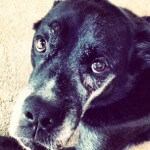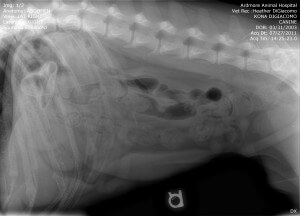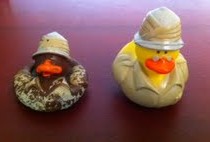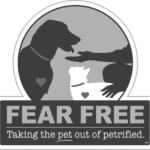Ew! My Dog Ate What?
August 10, 2012
 Seeing a commercial for a new show on the National Geographic Channel called “My Dog Ate What?” got me thinking about my own dog Kona, pictured here. Kona, like so many of my canine patients, has a penchant for what we in the veterinary industry like to call “dietary indiscretions”. This means Kona will eat anything, anywhere, any time, and of any size/shape/consistency/flavor. To my knowledge, in his nine years of life, Kona has eaten at least two pairs of sunglasses, a flip flop bought as a souvenir from my Hawaiian honeymoon, whole tomatoes from the kitchen counter, many of my son’s diapers (thankfully clean ones), baby wipes, tennis balls, cherished stuffed animals, the coffee filter from our coffee pot, and then some. When I poop scoop our doggie yard, I know which specimens belong to Kona because his invariably are rainbow-colored, riddled with the many foreign objects he consumed that week.
Seeing a commercial for a new show on the National Geographic Channel called “My Dog Ate What?” got me thinking about my own dog Kona, pictured here. Kona, like so many of my canine patients, has a penchant for what we in the veterinary industry like to call “dietary indiscretions”. This means Kona will eat anything, anywhere, any time, and of any size/shape/consistency/flavor. To my knowledge, in his nine years of life, Kona has eaten at least two pairs of sunglasses, a flip flop bought as a souvenir from my Hawaiian honeymoon, whole tomatoes from the kitchen counter, many of my son’s diapers (thankfully clean ones), baby wipes, tennis balls, cherished stuffed animals, the coffee filter from our coffee pot, and then some. When I poop scoop our doggie yard, I know which specimens belong to Kona because his invariably are rainbow-colored, riddled with the many foreign objects he consumed that week.
How, do you ask, does this “veterinary professional” allow her dog to continue to have access to all these foreign objects? Kona, even at 9 years of age, is kept in a crate every single time we leave the house. When we are home, he is usually in my husband’s office while my husband works, or confined to a portion of the kitchen via baby gate. Kona is in virtual lockdown at all times in our home, yet he still seems to find objects to consume. Often these objects are things he’s seen and ignored for years; then, suddenly, he is possessed by the Spirit of Dietary Indiscretion, and decides to eat the remote control that has been on our coffee table for the past six years. Because he’s so unpredictable with what he will eat and when, and because I have a three year old son who indiscriminately leaves toys throughout the house, Kona still manages to eat things he shouldn’t.
When dogs have dietary indiscretions, significant health problems can result. Most commonly, grazing on trash or items on the street can result in gastroenteritis (vomiting and diarrhea) and sometimes pancreatitis; this can often be managed with supportive care such as fluids, antiemetics to stop nausea and vomiting, and appropriate therapy for diarrhea. Some dietary indiscretions, such as those involving prescription medications or foods such as chocolate, can result in toxicity and need to be addressed right away by your veterinarian; we always recommend clients call the ASPCA Poison Control number before coming to our clinic, to determine the best course of treatment for a toxic ingestion. Finally, a small percentage of dietary indiscretions result in gastric or intestinal obstructions, where the dog cannot pass food through the GI tract because a foreign object is blocking the path. Obstructions invariably cause lots of vomiting, but they can be tricky to diagnose. In rare instances, this can be a life-threatening situation if the stomach or intestine perforates.

Despite Kona’s myriad ingestions over the years, fortunately only one has caused him a significant problem (and me a significant amount of stress!) About a year ago, Kona woke up one morning and refused to eat his breakfast. He had vomited a few times the preceding week, but we didn’t think much of it since he does that now and then. Kona had never missed a meal in nine years, and generally wolfs down his food in 8 seconds flat. When he didn’t eat, I knew something was dramatically wrong. So, I brought Kona to Newtown Square Veterinary Hospital, and we took this radiograph (x-ray) of his abdomen. Do you see anything there that shouldn’t be? An object to the upper left of the photograph, under the ribcage, approximately in the shape of a sombrero?
Ah, yes, Kona finally had his very own gastric foreign body. Sigh. Since the radiograph confirmed that the foreign object was still in his stomach, I thought there was a chance it could be removed with an endoscope instead of having to remove it via a large surgical incision into the abdomen and stomach. Our practice does not have a scope, so I brought Kona to a local board-certified surgeon with whom we work closely. We anesthetized Kona, and began the endoscopy. The scope revealed a large object present in the body of the stomach, but it was covered in food and hair, so the true nature of the foreign body had not yet revealed itself. The surgeon tried repeatedly to snare the object through his scope, but it was large enough that it kept falling back into the stomach every time he tried to bring it back through the more narrow esophagus. Finally, the surgeon gave up and we were about to take Kona for a gastrotomy (surgery to open the stomach); as the endoscope and snare were being pulled out, the surgeon inadvertently snagged the foreign body and successfully pulled it up and out. Success! To this day, the surgeon says this was the largest object he had ever retrieved with a scope.
 So what was this foreign body? My son’s rubber ducky. Swallowed whole. We guess it had been in Kona’s stomach for several months since my son hadn’t played with his rubber duckies in quite some time. The soft rubber had transformed into rock hard plastic, and the yellow color had morphed to brown, after several weeks of exposure to gastric acid. Kona made an uneventful recovery, and remains in “lock down” to try and prevent future ducky ingestion. (The “ingested” duck is shown on the left, and the original on the right.)
So what was this foreign body? My son’s rubber ducky. Swallowed whole. We guess it had been in Kona’s stomach for several months since my son hadn’t played with his rubber duckies in quite some time. The soft rubber had transformed into rock hard plastic, and the yellow color had morphed to brown, after several weeks of exposure to gastric acid. Kona made an uneventful recovery, and remains in “lock down” to try and prevent future ducky ingestion. (The “ingested” duck is shown on the left, and the original on the right.)
What should you do at home to prevent Fido’s own foreign body ingestion? If your dog is known to “graze” on objects in the house, it is best he is confined to a crate whenever you are not home. Provide plenty of exercise; if Fido is bored, he is more likely to counter surf. If you have a suspicion Fido has separation anxiety, he may be more apt to destroy items in the home when you leave the house; speak with your veterinarian to help remedy this common issue. Install locks on cabinets, refrigerators, trash cans and doors if necessary.
And remember, even the pets owned by us veterinary professionals can get into trouble sometimes! All rubber duckies in our home are now under lock and key.



